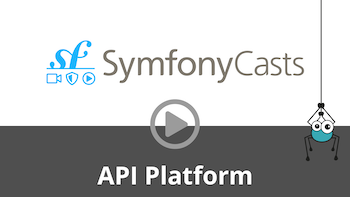# Data Persisters
To mutate the application states during `POST`, `PUT`, `PATCH` or `DELETE` [operations](operations.md), API Platform uses
classes called **data persisters**. Data persisters receive an instance of the class marked as an API resource (usually using
the `@ApiResource` annotation). This instance contains data submitted by the client during [the deserialization
process](serialization.md).

Watch the Data Persister screencast
A data persister using [Doctrine ORM](https://www.doctrine-project.org/projects/orm.html) is included with the library and
is enabled by default. It is able to persist and delete objects that are also mapped as [Doctrine entities](https://www.doctrine-project.org/projects/doctrine-orm/en/current/reference/basic-mapping.html).
A [Doctrine MongoDB ODM](https://www.doctrine-project.org/projects/mongodb-odm.html) data persister is also included and can be enabled by following the [MongoDB documentation](mongodb.md).
However, you may want to:
* store data to other persistence layers (Elasticsearch, external web services...)
* not publicly expose the internal model mapped with the database through the API
* use a separate model for [read operations](data-providers.md) and for updates by implementing patterns such as [CQRS](https://martinfowler.com/bliki/CQRS.html)
Custom data persisters can be used to do so. A project can include as many data persisters as needed. The first able to
persist data for a given resource will be used.
## Creating a Custom Data Persister
To create a data persister, you have to implement the [`ContextAwareDataPersisterInterface`](https://github.com/api-platform/core/blob/main/src/DataPersister/ContextAwareDataPersisterInterface.php).
This interface defines only 3 methods:
* `persist`: to create or update the given data
* `remove`: to delete the given data
* `supports`: to check whether the given data is supported by this data persister
Here is an implementation example:
```php
namespace App\DataPersister;
use ApiPlatform\Core\DataPersister\ContextAwareDataPersisterInterface;
use App\Entity\BlogPost;
final class BlogPostDataPersister implements ContextAwareDataPersisterInterface
{
public function supports($data, array $context = []): bool
{
return $data instanceof BlogPost;
}
public function persist($data, array $context = [])
{
// call your persistence layer to save $data
return $data;
}
public function remove($data, array $context = [])
{
// call your persistence layer to delete $data
}
}
```
If service autowiring and autoconfiguration are enabled (they are by default), you are done!
Otherwise, if you use a custom dependency injection configuration, you need to register the corresponding service and add the
`api_platform.data_persister` tag. The `priority` attribute can be used to order persisters.
```yaml
# api/config/services.yaml
services:
# ...
App\DataPersister\BlogPostDataPersister: ~
# Uncomment only if autoconfiguration is disabled
#tags: [ 'api_platform.data_persister' ]
```
Note that if you don't need any `$context` in your data persister's methods, you can implement the [`DataPersisterInterface`](https://github.com/api-platform/core/blob/main/src/DataPersister/DataPersisterInterface.php) instead.
## Decorating the Built-In Data Persisters

Watch the Data Persister Decoration screencast
If you want to execute custom business logic before or after persistence, this can be achieved by [decorating](https://symfony.com/doc/current/service_container/service_decoration.html) the built-in data persisters.
The next example uses [Symfony Mailer](https://symfony.com/doc/current/mailer.html). Read its documentation if you want to use it.
Here is an implementation example which sends new users a welcome email after a REST `POST` or GraphQL `create` operation, in a project using the native Doctrine ORM data persister:
```php
namespace App\DataPersister;
use ApiPlatform\Core\DataPersister\ContextAwareDataPersisterInterface;
use App\Entity\User;
use Symfony\Component\Mailer\MailerInterface;
final class UserDataPersister implements ContextAwareDataPersisterInterface
{
private $decorated;
private $mailer;
public function __construct(ContextAwareDataPersisterInterface $decorated, MailerInterface $mailer)
{
$this->decorated = $decorated;
$this->mailer = $mailer;
}
public function supports($data, array $context = []): bool
{
return $this->decorated->supports($data, $context);
}
public function persist($data, array $context = [])
{
$result = $this->decorated->persist($data, $context);
if (
$data instanceof User && (
($context['collection_operation_name'] ?? null) === 'post' ||
($context['graphql_operation_name'] ?? null) === 'create'
)
) {
$this->sendWelcomeEmail($data);
}
return $result;
}
public function remove($data, array $context = [])
{
return $this->decorated->remove($data, $context);
}
private function sendWelcomeEmail(User $user)
{
// Your welcome email logic...
// $this->mailer->send(...);
}
}
```
Even with service autowiring and autoconfiguration enabled, you must still configure the decoration:
```yaml
# api/config/services.yaml
services:
# ...
App\DataPersister\UserDataPersister:
decorates: 'api_platform.doctrine.orm.data_persister'
# Uncomment only if autoconfiguration is disabled
#arguments: ['@App\DataPersister\UserDataPersister.inner']
#tags: [ 'api_platform.data_persister' ]
```
